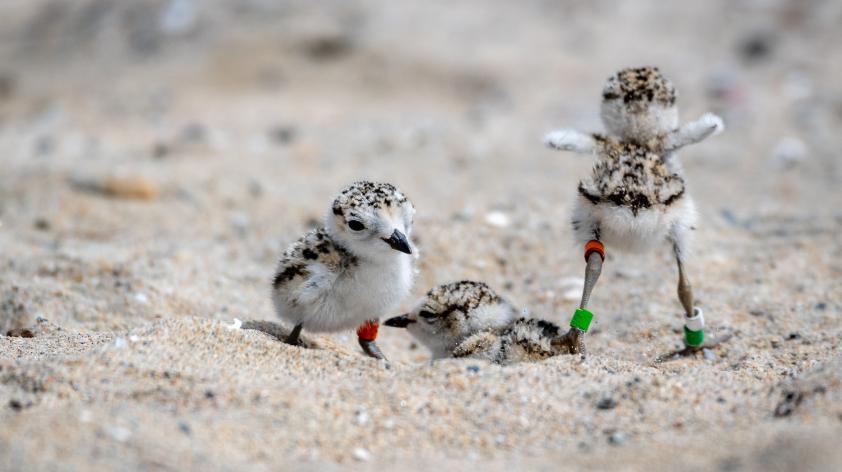
Color bands: the ID badges of the bird world
Every nesting season, between March and September approximately, there is new life to be discovered at Marine Corps Base Camp Pendleton and Naval Base Coronado. Fuzzy, speckled western snowy plover and California least tern chicks can be seen running along the sandy shores--more like waddling in the case of the least terns--or crouching to hide in the vegetation if their parents call to them to warn that danger is near.
As these federally-listed little balls of fluff grow bigger, develop pin feathers, and eventually learn how to take flight, individuals become much more difficult to identify and monitor since they often travel many miles from their natal nest sites. This is where the San Diego Zoo Global's Institute for Conservation Research (ICR) Terns and Plovers Team comes in!
Since part of the team’s job during daily site visits is to find and keep track of nests, they are able to capture the chicks shortly after they’ve hatched (the older they get, the faster they can run!) and apply USGS metal service bands with individual identification numbers so that they know who’s who for subsequent recaptures.
Additionally, since the legs of newly hatched snowy plover chicks are already close to adult size, we are also able to apply plastic color bands. This allows the birds to be identified from a distance without needing to be recaptured.
For plovers at Camp Pendleton, different colored metal service bands with an inscribed 9-digit code are applied to the upper left leg (above the joint), one plastic color band is applied to the lower left leg, and two plastic color bands are applied together on the lower right leg. The color band combinations are recorded as acronyms, with capital letters signifying a band on the upper leg above the joint, and a colon separating the left and right legs.
This leads to some individual birds earning fun nicknames such as “Po:rk” (pink on the left upper leg, orange on the left lower leg, red and black on the right lower leg) and “Po:ww” (pink upper left, orange lower left, and two white bands on lower right). The application of specific color combinations for plovers is carefully coordinated among researchers, an effort led by Point Blue Conservation Science, with approval from the U.S. Geological Survey Bird Banding Laboratory. Travis Wooten, a member of our Terns and Plovers team, is the coordinator for our region, Recovery Unit 6.
The USGS’s Bird Banding Lab reviews proposals, approves banding permits, and keeps track of each color band combination, to ensure that each bird’s identifying band pattern is unique. Researchers can tell where an individual bird was originally banded based on the color combination--even if that bird has travelled hundreds of miles!
By using color bands as an identification system, researchers at ICR along with partner institutions, can collect information on movement and migration patterns, survival rates, and site fidelity.
Because western snowy plovers are in decline, in large part due to habitat loss, it is critical to monitor individuals to get a big-picture idea of how effective recent recovery efforts have been. Data collected at Camp Pendleton and Coronado can also be used to inform future population management strategies, shifting habitat needs, and hopefully aid in the conservation of these unique shorebirds.
You too can help us collect important data by photographing and reporting band combinations (for more information, visit: http://pcbirds.org/).













